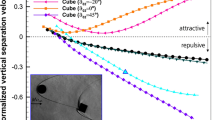Abstract
This paper discusses the numerical modeling of the dynamic coupled analysis of the floating platform and mooring/risers using the asynchronous coupling algorithm with the purpose to improve the computational efficiency when multiple lines are connected to the platform. The numerical model of the platform motion simulation in wave is presented. Additionally, how the asynchronous coupling algorithm is implemented during the dynamic coupling analysis is introduced. Through a comparison of the numerical results of our developed model with commercial software for a SPAR platform, the developed numerical model is checked and validated.
Similar content being viewed by others
References
Aranha JAP (1991). Wave groups and slow motion of an ocean structure. 6th International Workshop on Water Waves and Floating Bodies, Woods Hole, MA, USA, 5–8.
Aranha JAP (1994). A formula for “Wave damping” in the drift of a floating body. J. Fluid Mechanics, 275, 147–155.
Bureau Veritas (2010). Hydrostar for experts user manual.
Chen XB, Rezende F (2009). Efficient computations of second order low frequency wave load. Proceedings of OMAE 2009, Honolulu, USA.
Clark PJ, Malenica S, Molin B (1993). An heuristic approach to wave drift damping. Applied Ocean Research, 15, 53–55.
Faltinsen OM (1990). Sea loads on ships and offshore structures. Cambridge University Press.
Garrett DL (1982). Dynamic analysis of slender rods. Journal of Energy resources technology. Transactions of ASME, 104, 302–307.
Jing X, Webster WC, Xu Q, Lambrakos K (2011). Coupled dynamic modeling of a moored floating platform with risers. Proceedings of the ASME 30th Inter. Conference on Ocean, Offshore and Arctic Engineering, Rotterdam, Netherlands, OMAE2011-49553.
Low YM, Langley RS (2006). Time and frequency domain coupled analysis of deepwater floating production systems. Applied Ocean Research, 28, 371–385.
Ma G (2009). Dynamic research of deepwater mooring line and riser based on elastic rod theory. Master Thesis, Harbin Engineering University, Harbin.
Newman JN (1974). Second-order, slowly varying forces on vessels in irregular waves. International Symposium on the Dynamics of Marine Vehicles and Structures in Waves, London, Mechanical Engineering Publications Ltd, UK, 182–186.
Pauling JR, Webster WC (1986). A consistent large-amplitude analysis of the coupled response of a TLP and tendon system. Proc. 5th OMAE Conf., Tokyo, Japan, 3, 126–133.
Ran Z, Kim MH (1997). Nonlinear coupled responses of a tethered spar platform in waves. International Journal of Offshore Polar Engineering, 7(2), 111–118.
Ran Z (2000). Coupled dynamic analysis of floating structures in waves and current. PhD Thesis, Texas A&M University, College Station.
Rho JB, Korobkin AA, Jung JJ, Shin HS, Lee WS (2007). Coupled analysis of deepwater floating system including VIV in time domain. Proceedings of the 26th Inter. Conf. on Offshore Mechanics and Arctic Engineering, San Diego, California, USA, OMAE2007-29523.
Steen A, Kim MH, Irani M (2004). Prediction of Spar responses: model tests vs. analysis. Offshore Technology Conference, Houston, TX, USA, OTC16583.
Author information
Authors and Affiliations
Corresponding author
Additional information
Foundation item: Supported by the National Natural Science Foundation of China under Grant No. 51109040.
Shan Ma was born in 1976. He is an associate professor at Harbin Engineering University. He was a visiting scholar at Texas A&M University, 2006–2007. His current research interests include ship seakeeping and global performance analysis of deepwater floating structures.
Wenyang Duan was born in 1967. He is presently a professor and supervisor of PhD candidates at Harbin Engineering University. He is now the Yangtze River Scholar Professor. His current research interests include ship seakeeping, hydrodynamics of ship and ocean structures, and the numerical wave tank technique.
Rights and permissions
About this article
Cite this article
Ma, S., Duan, W. Dynamic coupled analysis of the floating platform using the asynchronous coupling algorithm. J. Marine. Sci. Appl. 13, 85–91 (2014). https://doi.org/10.1007/s11804-014-1234-1
Received:
Accepted:
Published:
Issue Date:
DOI: https://doi.org/10.1007/s11804-014-1234-1




